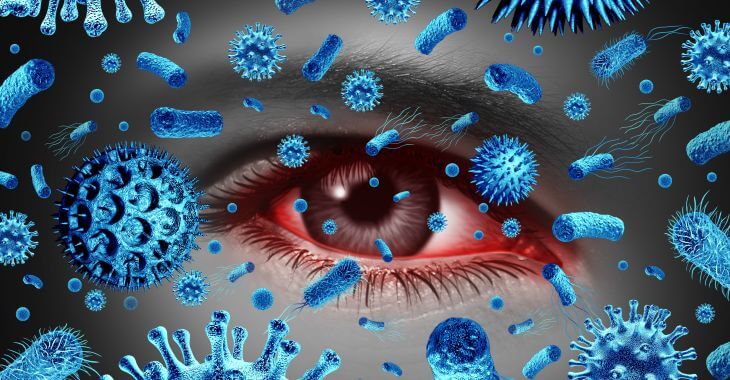What Is Commonly Misdiagnosed as Pink Eye?

Most adults have had “pink eye” as a child and may think that when their or their child’s eyes are red and swollen that they have pink eye. However, there are other conditions that can cause similar symptoms. What is commonly misdiagnosed as pink eye? Here is what you need to know.
Conjunctivitis is an inflammation of the conjunctiva, which is the clear, white layer that protects the eyeballs. When this layer gets inflamed, it can cause a red, swollen appearance to the eyes, which is often called “pink eye.” There are a few different types of conjunctivitis, including:
- Viral
- Bacterial
- Allergic
- Chemical
When most people refer to “pink eye,” they are talking about viral or bacterial infections that affect the eyes. These are contagious and can be spread from person to person. Children are very prone to contagious pink eye due to close contact with other children at school and play.
What Are the Early Symptoms of Pink Eye?
If you have true conjunctivitis, especially the viral or bacterial types, you will have irritated eyes and turn pink or red in color. It is important to know whether you have a bacterial or viral form of this eye condition to avoid spreading it to others. Symptoms include:
- Swollen eyes
- Pink or red whites of eyes
- Pus or discharge from eyes
- Crusting over the eyelids, especially at night
- Excessive watering or tearing
- Sensitivity to light
- Scratchy or itchy feelings
- Eye pain
Beyond bacterial or viral eye infections in the conjunctiva, allergens and chemicals can also cause conjunctivitis. These are not contagious, but they have the same potential to cause eye pain, redness, swelling and watering due to irritation to the conjunctiva and other parts of the eyes.
Conditions Misdiagnosed as Conjunctivitis
Since most people have had some type of conjunctivitis from colds, bacterial infections, allergies or exposure to chemicals, they may ignore their pink eyes. But there are other conditions that can cause eye irritation. What is commonly misdiagnosed as pink eye? Most commonly a stye.
Styes are an infection that occurs on the eyelids, but it can irritate the eyes. These eyelid infections are caused by bacteria infiltrating the eyelid oil glands, creating a lump. Some of the risk factors that contribute to getting styes more often include:
- Touching the eyes with unwashed fingers
- Not properly disinfecting contact lenses
- Using old eye cosmetics
- Not washing off eye makeup at night
Styes are not harmful and will usually go away on their own in a few days. But they do have many similar symptoms to pink eye, which is why they may be misdiagnosed as conjunctivitis.
Pink Eye vs. Stye
If you have red or pinkish eyes that are uncomfortable, watering and swollen, you may wonder whether you have conjunctivitis or a stye. When considering the differences between pink eye vs. stye, there are a few symptoms that each have that the other does not. Here are some key differences:
- Pink eye usually has a discharge from the eye, not the eyelid
- Styes have a lump on the eyelid that may look like a pimple, pink eye usually does not
- Pink eye can cause light sensitivity, which does not usually occur with styes
- Bacterial and viral pink eye are contagious and styes are not
- Conjunctivitis can affect both eyes, while styes usually only occur on one eye at a time
Treatment for non-contagious conjunctivitis and styes are similar. You can use a warm compress on the eyes to provide relief from the discomfort and it may help the eyes heal faster. Gently massaging the eyes and using eyedrops if they feel itchy or scratchy can provide relief.
When to See a Doctor for Pink Eye
If you or your child have symptoms of pink eye that are not related to a stye, allergies, or exposure to chemicals, you should see a doctor. It is best not to self-diagnose eye conditions as they can be contagious and may cause eye complications.
Your doctor can perform an exam and determine if you have viral or bacterial conjunctivitis. There are eyedrops that can be prescribed to help relieve the symptoms. If pink eye is caused by a bacterial infection, antibiotics may be prescribed to stop the infection. To stop the spread, you should:
- Avoid touching the eyes
- Not share towels or other items that touch the face
- Do not share cosmetics or medications that come close to the eyes
- Wash hands frequently
- Stay away from others until the infection clears
Viral pink eye, which is very common, cannot be treated with antibiotics, but it usually clears on its own within two weeks. Styes usually do go away on their own, but you may want to see a doctor if it does not begin to clear within 2-3 days.

If you have pink, swollen, painful and watering eyes, you may have conjunctivitis. If you are sure it is not a stye or allergies, you may want to visit your doctor for an accurate diagnosis.
The information provided on this website, including text, graphics, images, and other materials, is intended solely for informational purposes and should not be used as a substitute for professional medical advice, diagnosis, or treatment.


)